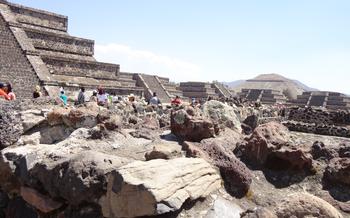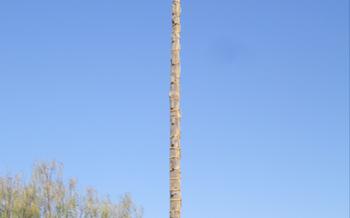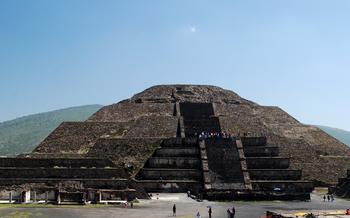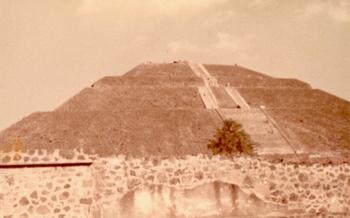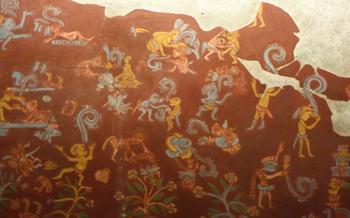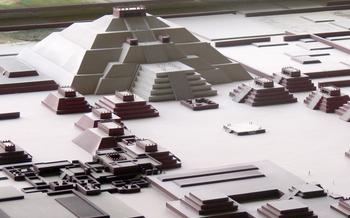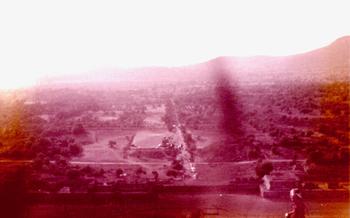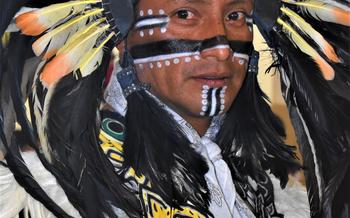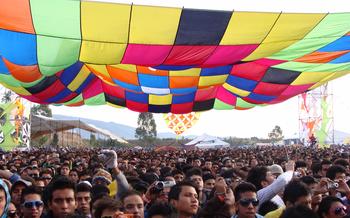
Palacio de Yayahuala
- Location and Accessibility
- Exploring the Palace Complex
- Murals and Artwork
- Daily Life and Rituals
- Social Hierarchy and Governance
- Tips for Visiting
- Photography and Videography
- Local Cuisine and Dining Options
- Cultural Performances and Events
- Sustainable Tourism
- Off-the-Beaten-Path Experiences
- Insider Tip: Unveiling a Hidden Gem
Location and Accessibility
The Palacio de Yayahuala is conveniently nestled amidst Teotihuacan's iconic landmarks, just a short stroll from the awe-inspiring Pyramid of the Sun. Its proximity to other major attractions, such as the Avenue of the Dead and the Pyramid of the Moon, makes it an ideal starting point for your exploration of this ancient city.
Reaching the palace is a breeze, with various transportation options at your disposal. Hop on the turístico buses that depart from Mexico City, ensuring a hassle-free journey. If you prefer a more personalized experience, guided tours are readily available, offering insightful commentary and historical context as you traverse the site.
For those who relish the freedom of self-exploration, navigating the Palacio de Yayahuala is a breeze. Clearly marked trails and informative signage guide you through the complex, allowing you to uncover its secrets at your own pace. Embrace the opportunity to wander off the beaten path, discovering hidden corners and tranquil spots that reveal the palace's hidden charm.
Exploring the Palace Complex
The Palacio de Yayahuala is a sprawling complex consisting of numerous courtyards, rooms, and living quarters, each serving a specific purpose. The central courtyard, known as the Patio de los Jaguares, is the largest and most impressive, featuring a series of intricately carved stone jaguar heads adorning its walls. The Temple of the Plumed Shells, located at the north end of the palace, is another notable feature, showcasing exquisite murals depicting feathered shells and other religious symbols.
Key architectural elements to look out for include the use of talud-tablero, a construction technique involving sloping walls and projecting moldings, as well as the presence of elaborately carved stone lintels and columns. These elements not only add to the aesthetic appeal of the palace but also provide insights into the advanced architectural skills of the Teotihuacan civilization.
Murals and Artwork
The Palacio de Yayahuala is adorned with vibrant murals that bring to life scenes from Teotihuacan's past. These intricate paintings offer a glimpse into the daily lives, rituals, and beliefs of the city's elite. The murals depict a variety of subjects, including religious ceremonies, feasting, entertainment, and scenes from everyday life.
The artwork is characterized by its use of bold colors, intricate lines, and symbolic imagery. Many of the murals feature representations of Teotihuacan's patron deities, such as the Feathered Serpent and the Rain God. The murals also provide valuable insights into the city's social structure and hierarchy, as they often depict the ruling class engaged in various activities.
The techniques used to create the murals are still not fully understood, but it is believed that the artists used a combination of natural pigments and minerals. The murals have been remarkably well-preserved over time, thanks to the dry climate of the region and the protective layers of plaster applied to them.
Daily Life and Rituals
The Palacio de Yayahuala offers a glimpse into the daily lives of Teotihuacan's elite and ruling class. The murals and artwork depict scenes of feasting, entertainment, and social gatherings, providing insights into the social customs and rituals of the time. Evidence suggests that the palace was a hub of activity, with lavish banquets and celebrations taking place within its walls.
Rituals and ceremonies played a significant role in Teotihuacan society, and the palace complex was a central location for these events. The Temple of the Plumed Shells, located within the palace, was likely used for religious ceremonies and rituals associated with the city's patron deity, Tlaloc, the god of rain and agriculture.
The palace also served as a venue for political gatherings and decision-making processes. Rulers and officials would meet in the Audience Chamber to discuss matters of governance and conduct diplomatic negotiations. The grandeur of the palace's architecture and its elaborate decorations reflected the power and prestige of Teotihuacan's ruling elite.
Social Hierarchy and Governance
The Palacio de Yayahuala held immense significance in Teotihuacan's political and administrative system. It served as the seat of power for the city's rulers and played a crucial role in governance. The palace complex was designed to reflect the social hierarchy and stratification that existed within Teotihuacan society.
The palace's grand architecture and lavish decorations symbolized the authority and prestige of the ruling class. It was here that important decisions were made, laws were enacted, and justice was administered. The palace also served as a venue for official ceremonies, diplomatic meetings, and the reception of foreign dignitaries.
The social hierarchy in Teotihuacan was complex and consisted of several levels. At the apex were the rulers, who held absolute power and were considered divine figures. Below them were the nobles, who assisted in governing the city and managing its affairs. The priests, who held significant influence due to their religious authority, formed another important stratum.
The commoners, who constituted the majority of the population, occupied the lower rungs of the social ladder. They were primarily engaged in agriculture, trade, and various crafts. The palacio de Yayahuala, as the center of political power, played a crucial role in maintaining this social structure and ensuring the smooth functioning of Teotihuacan's society.
Tips for Visiting
To make the most of your visit to the Palacio de Yayahuala, consider these practical tips:
-
Plan your visit for the early morning or late afternoon: The lighting is best during these times, and you'll avoid the midday crowds.
-
Combine your visit with other nearby attractions: The Palacio de Yayahuala is located near several other major attractions, including the Pyramid of the Sun, the Pyramid of the Moon, and the Temple of Quetzalcoatl. You can easily combine your visit to the palace with one or more of these sites to make a full day of exploring Teotihuacan.
-
Take advantage of guided tours: Guided tours are available for the Palacio de Yayahuala and other Teotihuacan attractions. These tours can provide valuable insights into the history, culture, and significance of the site.
-
Bring comfortable shoes and clothing: You'll be doing a lot of walking at Teotihuacan, so make sure to wear comfortable shoes and clothing. The site is also exposed to the sun, so a hat and sunscreen are recommended.
-
Bring water and snacks: There are no food or beverage vendors at the Palacio de Yayahuala, so bring your own water and snacks.
-
Be respectful of the site: The Palacio de Yayahuala is a UNESCO World Heritage Site, and it's important to be respectful of the site and its cultural significance. Do not climb on the structures or touch the artwork.
Photography and Videography
When visiting the Palacio de Yayahuala, capturing the grandeur of the ancient palace through photography and videography is a must. Here are some guidelines and tips to make the most of your documentation:
-
Respect the Site: Remember that the Palacio de Yayahuala is a sacred and historic site. Always respect the regulations and guidelines set in place to protect the palace and its surroundings.
-
Lighting: The best time to take photos and videos is during the golden hours, just after sunrise or before sunset, when the warm light enhances the palace's architectural details.
-
Composition: Experiment with different angles and perspectives to create dynamic shots. Capture the palace's grandeur by including the surrounding landscape and other iconic structures.
-
Tripod: Bring a tripod to stabilize your camera, especially for low-light conditions or long exposure shots. This will help you achieve sharp and clear images.
-
Flash: Using flash photography is generally not allowed inside the palace to protect the delicate murals and artwork. Natural light is usually sufficient for capturing the palace's beauty.
-
Respect Others: Be mindful of other visitors and avoid blocking their views or disturbing their experience while taking photos or videos.
Local Cuisine and Dining Options
When visiting the Palacio de Yayahuala, don't miss the opportunity to savor the delectable flavors of Teotihuacan's culinary traditions. From traditional Mexican dishes to modern fusion cuisine, there's something to satisfy every palate.
For an authentic experience, head to one of the local restaurants near the palace. Try the mouthwatering barbacoa, a succulent slow-cooked lamb or goat dish served with a flavorful broth and fresh tortillas.
Cultural Performances and Events
The Palacio de Yayahuala and the surrounding area of Teotihuacan are not just about ancient ruins and historical exploration. The region is also alive with cultural performances and events that showcase the vibrant heritage of Mexico. From traditional dance and music to colorful festivals, there are many ways to experience Teotihuacan's cultural side.
One of the highlights is the traditional dance performance known as the Danza de los Concheros. Performed by local groups dressed in elaborate costumes, this dance is a tribute to the ancient Teotihuacan civilization and its rituals. The rhythmic movements, accompanied by the sound of conch shells and drums, create a captivating spectacle that transports visitors back in time.
Music also plays an important role in Teotihuacan's cultural scene. Traditional Mexican music, such as mariachi bands and folkloric ensembles, can be heard throughout the region. These performances often take place in the plazas or courtyards near the Palacio de Yayahuala, creating a lively and festive atmosphere.
Throughout the year, Teotihuacan hosts various festivals and events that celebrate the region's cultural heritage. The most famous is the annual Festival de la Muerte (Day of the Dead Festival), which takes place around November 1st and 2nd. During this festival, the streets come alive with colorful decorations, altars, and offerings to honor the deceased. Visitors can witness traditional rituals, parades, and performances that celebrate the unique blend of ancient and modern Mexican traditions.
By attending these cultural performances and events, visitors can gain a deeper understanding of Teotihuacan's rich cultural heritage and the vibrant traditions that continue to shape the region's identity. Whether it's the mesmerizing dances, the soulful music, or the festive atmosphere of the festivals, these experiences offer a glimpse into the heart and soul of Teotihuacan.
Sustainable Tourism
As responsible travelers, it's essential to minimize our impact on the environment and respect the cultural heritage of the Palacio de Yayahuala. Here are some tips for practicing sustainable tourism during your visit:
-
Reduce plastic waste: Bring your own water bottle and avoid single-use plastic items like bags and straws.
-
Respect the wildlife: Observe animals from a distance and avoid disturbing their natural habitats.
-
Support local businesses: Choose restaurants and shops that are owned and operated by local people.
-
Leave no trace: Dispose of your trash properly and avoid leaving any footprints or markings on the site.
-
Educate yourself: Learn about the history and culture of Teotihuacan before your visit. This will help you appreciate the site's significance and contribute to its preservation.
By following these principles, you can help protect the Palacio de Yayahuala for future generations while enjoying a fulfilling and sustainable travel experience.
Off-the-Beaten-Path Experiences
While the main areas of the Palacio de Yayahuala are impressive, venturing off the beaten path can lead to hidden gems and unique perspectives. Explore the lesser-visited sections of the palace complex to discover secluded courtyards, hidden chambers, and intricate architectural details often missed by crowds.
Seek out the Temple of the Feathered Serpent, located at the far end of the complex. This lesser-known temple features stunning carvings and murals depicting the feathered serpent deity, Quetzalcoatl. The serene atmosphere and lack of crowds make it an ideal spot for contemplation and photography.
Another hidden gem is the Patio of the Columns, tucked away behind the main courtyard. This secluded area features rows of towering columns that create a sense of grandeur and mystery. Take your time to admire the intricate carvings on the columns and soak in the tranquility of this hidden oasis.
Remember to respect the site's regulations and guidelines while exploring off-the-beaten-path areas. Stay on designated paths, avoid touching or climbing on structures, and be mindful of other visitors. By following these guidelines, you can contribute to the preservation of this ancient site while enjoying a unique and memorable experience.
Insider Tip: Unveiling a Hidden Gem
As you explore the Palacio de Yayahuala, keep an eye out for a hidden gem that offers a breathtaking perspective of the surrounding landscape. Tucked away from the main paths, this secluded spot allows you to immerse yourself in the serenity and grandeur of Teotihuacan.
To access this secret viewpoint, look for a discreet side entrance near the Temple of the Plumed Shells. Follow a narrow path that winds its way through lush vegetation, leading you to a secluded platform overlooking the vast expanse of the ancient city.
From this vantage point, you can marvel at the majestic Pyramid of the Sun and the Pyramid of the Moon, rising prominently in the distance. The panoramic vista extends beyond the archaeological site, showcasing the rolling hills and vibrant greenery that envelop Teotihuacan.
Remember to respect the site's regulations and guidelines while venturing into hidden areas. Stay on designated paths, avoid touching or damaging any structures or artifacts, and be mindful of your surroundings. This hidden gem is a privilege to experience, and it's essential to preserve its beauty for future generations.
